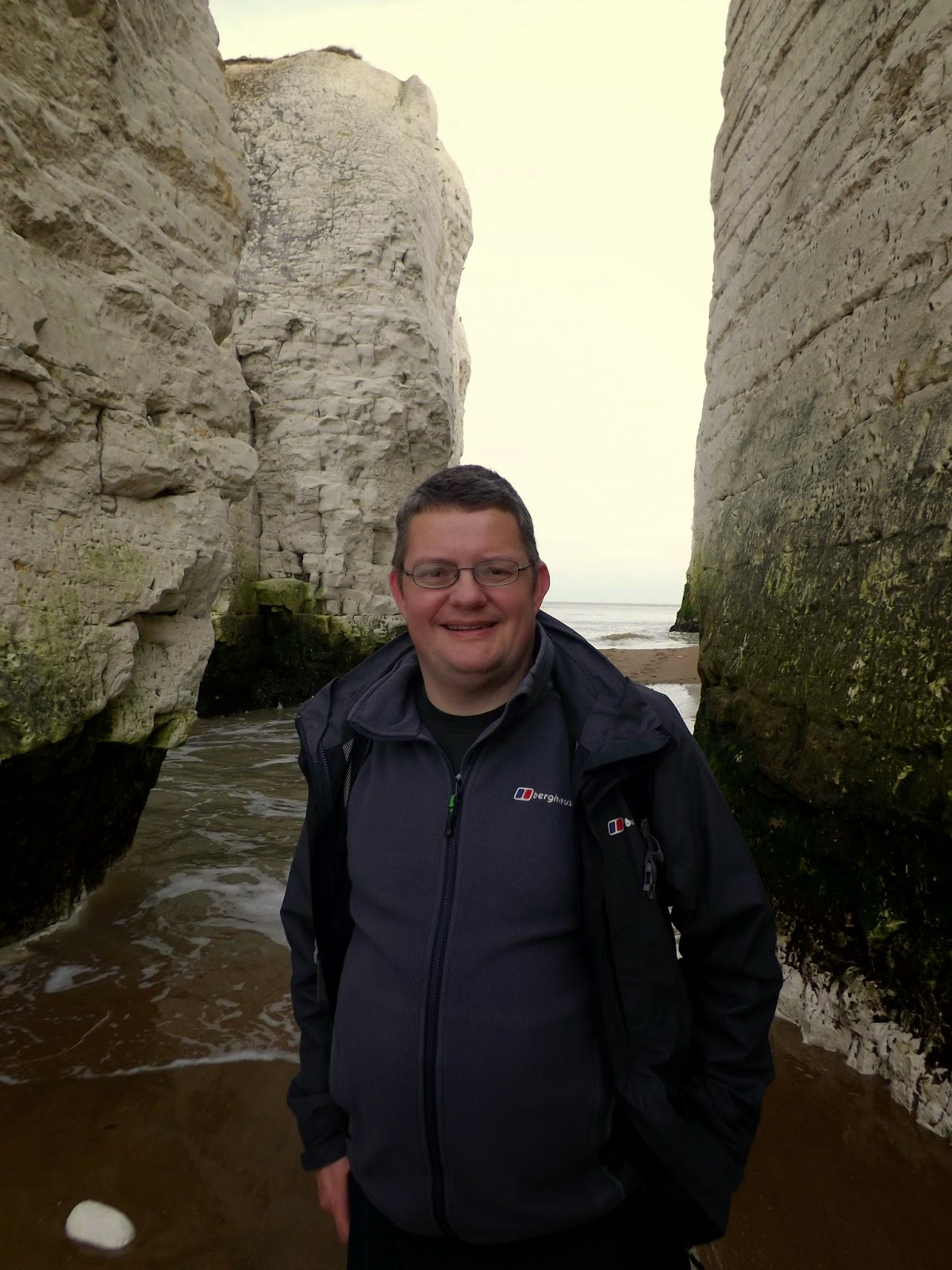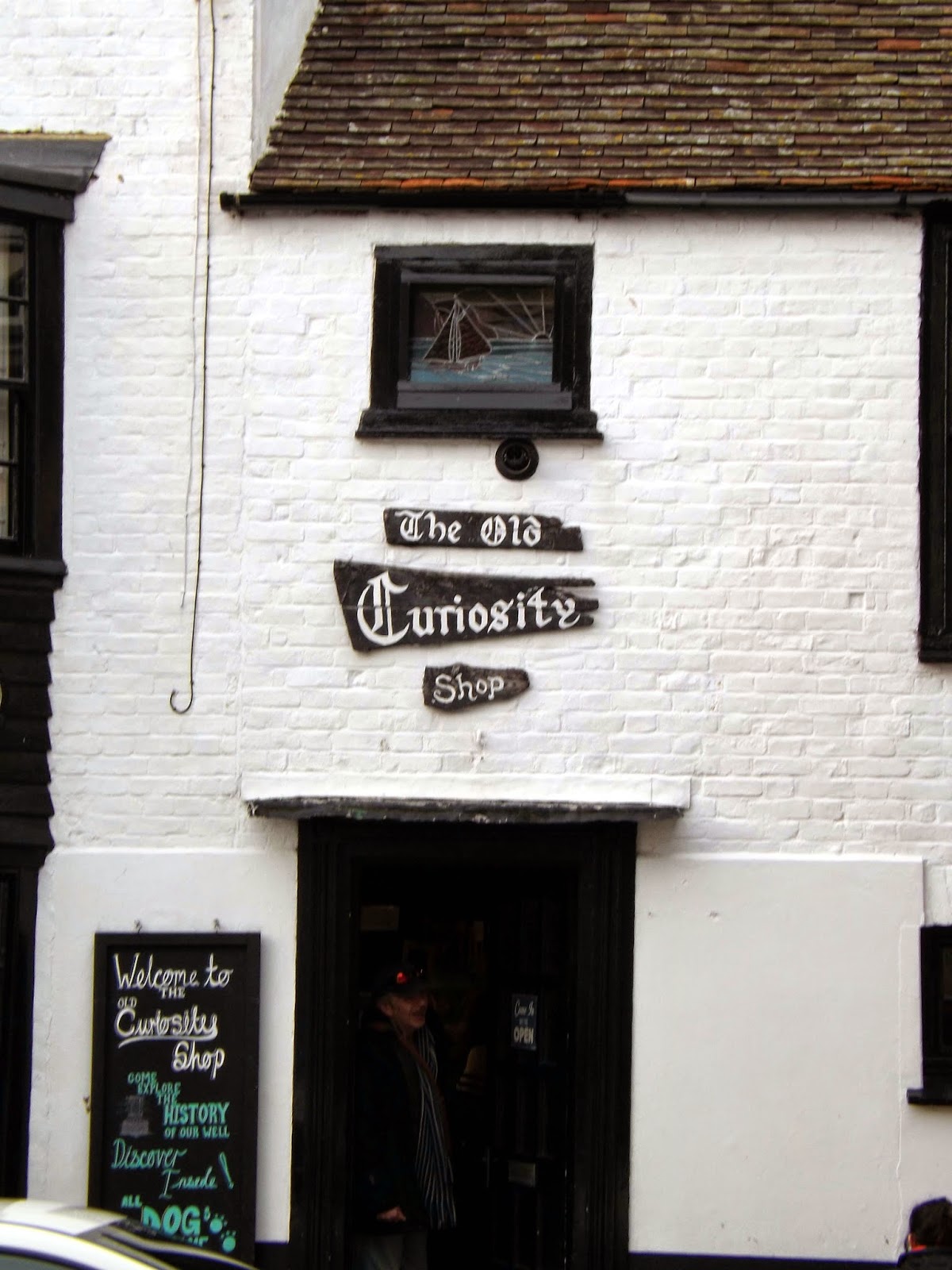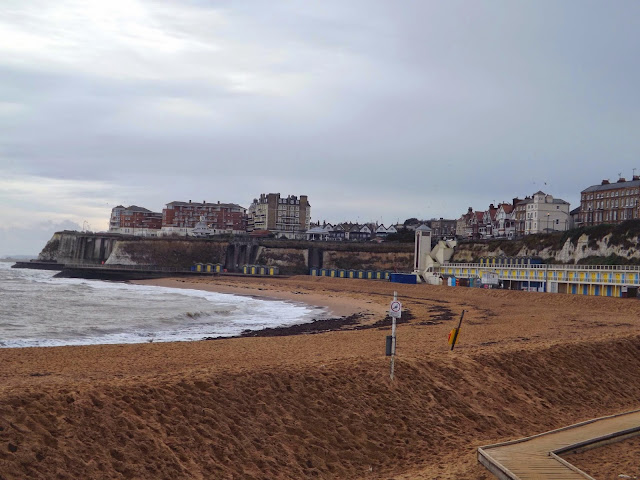Dan and I left home and set off for Margate on the Kent Coast on 7th January 2015. This walk seemed ideal as it would be a mud free walk after the all the recent rain we have had. We arrived at Margate at about 11.15am and parked up free of charge in Albert Road near the Rail Station.
We left the car and walked toward the seafront.
Margate was recorded as "Meregate" in 1264 and as "Margate" in 1299, but
the spelling continued to vary into modern times. The name is thought
to refer to a pool gate or gap in a cliff where pools of water are
found, often allowing swimmers to jump in.
 | |||||
| Memorial to the crew, Margate, by Frederick T Callcott |
We passed Dreamland that has long since been closed but is due to re-open in 2015, they are still rebuilding The Scenic Railway after a fire destroyed 25% of it in April 2008. The scenic Railway was Grade II listed in 2002. Dreamland hold a lot of childhood memories for me after Mum And Dad took there a few times back in the 80s.
There is a Dreamland Expo running from 6th September 2014 to 30th March 2024 open on the weekends, sadly being a Wednesday it was closed.
Just a little way up is the Margate Clock Tower.
This clock tower was constructed to celebrate the Golden Jubilee of Queen Victoria in 1887 but was not complete until 1889.
The tower holds five bells and above these was a time ball which
used to raise just before 1pm and drop on the hour. The time ball has
not worked for many years.
We now reached The Turner Contemporary Exhibition Centre by the pier.
Inspired by JMW Turner’s sense of enquiry, we offer a space for everyone to embrace their curiosity and to discover different ways of seeing, thinking and learning. This is free entry but a £3 donation is requested but not compulsory.
After a brief look around The Turner Exhibition, we crossed the road and after Dan stopped to buy some sticks of rock we walked along King Street. The lady in the shop was very chatty, obviously not too many customers in the winter. She was telling us of her recent trip to Greenwich London, couldn't help thinking of the irony so many Londoners travelling to the Kent coast to escape the city and here was this lady and her husband swanning off to London.
 |
| King Street,Margate |
We stopped and Dan checked the map on his phone to try and find The Shell Grotto we wished to visit.
We walked back onto King St and passed The Tudor House on King Street itself.
The House is one of Margates oldest buildings dating back to the first half of the 16th century.Admission is £1.50 for adults but closed probably due to being Winter.
The
Tudor House is one of the Margate’s oldest buildings, dating back to
the first half of the sixteenth century. - See more at:
http://www.visitthanet.co.uk/attractions/tudor-house-margate/9908#sthash.QsJX7LLU.dpuf
The
Tudor House is one of the Margate’s oldest buildings, dating back to
the first half of the sixteenth century. - See more at:
http://www.visitthanet.co.uk/attractions/tudor-house-margate/9908#sthash.QsJX7LLU.dpuf
The
Tudor House is one of the Margate’s oldest buildings, dating back to
the first half of the sixteenth century. - See more at:
http://www.visitthanet.co.uk/attractions/tudor-house-margate/9908#sthash.QsJX7LLU.dpuf
We eventually find The Shell Grotto this was also closed and only open on weekends during the Winter. I was some what disappointed but we pressed on instead with the walk.
The Shell Grotto, where you’ll find 4.6million shells, 70ft of winding underground passages leading to a rectangular chamber, 2000sqft of mosaic and one big mystery!
The story goes that in 1835 Mr James Newlove lowered his young son Joshua into a hole in the ground that had appeared during the digging of a duck pond. Joshua emerged describing tunnels covered with shells. He had discovered the Shell Grotto, its walls decorated with strange symbols mosaiced in millions of shells. Is it an ancient pagan temple? A meeting place for some secret cult? Nobody can explain who built this amazing place, or why, but since its accidental discovery visitors from all over the world have been intrigued by the beautiful mosaic and the unsolved mystery.
We walk into Dalby Square This was the location where the Villa Bella once stood, now some newly built flats. It appeared in The Only Fools And Horses Jolly Boys Outing Christmas Special of 1989.
We now walk back by the sea and pass the Margate Lido and turn right to follow the sea.
We pass the HM Coastguard,Margate and continue along Princes walk towards Botany Bay.
We now reach Palm Bay.
We now reach Botany Bay, what a wonderful find a real jewel, a superb beach and bay. One I must return to to enjoy it in the sunshine!
It is said that Botany Bay found its name when those found in possession of smuggled goods were deported to Botany Bay in Australia; you may not see many smugglers on the sands these days, just holiday makers after quiet relaxation getting away from it all. When the tide is out it is great for fossils and exploring rock pools. Plenty of exposed sand to enjoy when the tide is in but due to its shape at high tide the ends of the beach are cut off.
It
is said that Botany Bay found its name when those found in possession
of smuggled goods were deported to Botany Bay in Australia; you may not
see many smugglers on the sands these days, just holiday makers after
quiet relaxation getting away from it all. When the tide is out it is
great for fossils and exploring rock pools. Plenty of exposed sand to
enjoy when the tide is in but due to its shape at high tide the ends of
the beach are cut off. - See more at:
http://www.visitthanet.co.uk/attractions/botany-bay/8670#sthash.p5m0FkiG.dpuf
Dog ban in place from 1st May until 30th September, dogs not permitted between 10am to 6pm.
Dog
ban in place from 1st May until 30th September, dogs not permitted
between 10am to 6pm. - See more at:
http://www.visitthanet.co.uk/attractions/botany-bay/8670#sthash.p5m0FkiG.dpuf
I really must return here in the summer to enjoy a swim and to relax on the beach!
 |
| One of many faces and engravings in the chalk |
We left the bay and stopped at The Botany Bay Hotel for a half pint of Whitstable Bay Blonde Lager. To be fair I felt out of place here, felt far too much upmarket for me in my walking clothes and decided to have the drink outside away from the people eating and to enjoy the views.
Almost gave up at one point,waited quite a while to be served, seems everyone was busy serving food.
Whitstable Bay Blonde Lager is a contemporary lager featuring an intricate taste profile, distinguished by its unique hop character. Gaining its name from the golden hue of the beer, it offers an enhanced drinking experience through the floral aroma, paired with buttery biscuit base notes, while avoiding the bitter aftertaste common with hoppy beers.
A pale, refreshing lager with spicy overtones perfectly balanced by the scent of fresh flowers. ABV 4.5%
We left the pub and continued along the path and come upon Neptunes Tower.
Neptune’s Tower is the ruin of a folly which was built by Henry Fox, 1st Baron Holland, in the 18th Century. It is one of several follies surrounding his Broadstairs home of Kingsgate Castle. Follies are built primarily for decoration, and extravagant decoration at that. This one had a large central tower, but that no longer exists.
Now as we turn the corner Kingsgate Castle comes into view. The “Castle” was built by Lord Holland (Henry Fox) in the 1760’s. The building was converted into 31 flats, and is maintained by a management agency should you wish to use the grounds or buildings.
Now we reach the Captain Digby PH. Originally built as the stable block for Bede House it was changed into a hostelry after the main house fell into the sea. A tunnel (now blocked off and once used for smuggling) led from the cellar into a cave below at Kingsgate Bay. The hostelry was frequented by smugglers and served as an “employment centres” the building has been altered and extended from the time it was used by smugglers in the 18th Century. The Captain Digby is owned by Thorley Taverns.
We reach Kingsgate Bay another gem of a bay and very pretty too.
Some of
the best examples of sea caves in the country can be found at Kingsgate Bay.
The sandy bay offers calm and seclusion, while sand is exposed at full tide,
the beach does get cut off at both ends.
This bay
is dog friendly all year round.
Upon walking onto the beach Dan found a discarded skipping rope and proceeded to show his skipping skills.
We walked back up onto the road and now pass the front of Kingsgate Castle.
Following the road along we get our first view of North Foreland Lighthouse,behind a field of very smelly cabbages.
 |
| Looking back down the steep hill up to the lighthouse. |
Built in 1691 and was constructed of brick, stone and flint. The lighthouse was bought by Trinity House in 1832 and added a separate room in 1890 – the lantern house. In 1998 it became the last of the Trinity Lighthouses to be automated. The Lighthouse Keepers Cottages were built in 1860 are attached to the Lighthouse by one storey corridors. The lighthouse and the lighthouse keepers houses are both Grade II listed buildings.
Now after a small detour taking the wrong road back down to the cliff edge we are now walking along East Cliff heading into Broadstairs.
I now come upon Bleak House,Fort Road in Broadstairs itself. It was originally known as Fort House and was built around 1816 for a Captain during the Napoleonic wars. Charles Dickens wrote several of his famous novels and the building was leased to him between 1837 and 1859. The four storey Grade II listed building was renamed Bleak House after his death in 1870.
Broadstairs, like many coastal places around England, had something of a reputation for smuggling in the 18th and early 19th centuries. The current establishment has a Smugglers Museum below deck.It is still possible to visit one of Charles Dickens' study rooms there.
Dickens wrote perhaps his most meritous work, David Copperfield. Fort House was dubbed Bleak House in the early part of the 20th Century. Somebody asserted that it was the Bleak House referred to in Dickens' 1853 novel and the name stuck.
A quick bit of fun in the amusement arcade we had a walk around the town.
Looking over Viking Bay, it looked so different from when I last was here in the summer many years back. Back then the beach was full of sunbathers,children playing in the sea, trampolines and bouncy castles., but now being Winter the beach is empty and quiet.
We came to Dickens House , now a museum but also closed as its Winter!
Dickens House - 2 Victoria Parade, Broadstairs CT10 1QS.
Charles Dickens used to visit this building to see Miss Mary Pearson Strong, he based Miss Betsey Trotwood on Miss Pearson Strong in his 1850 novel David Copperfield.As with all our coastal walks we stopped off for some well earned Cod and chips after a 9 mile walk.This was the first chip shop we found open as many were closed for the Winter it would seem.
We walked back to Broadstairs Rail Station and could see Crampton Tower Museum also closed.
The building is currently used as a small museum in the flint tower which is adjacent to Broadstairs railway station. The tower formed part of the first Broadstairs public water supply. The building has Thomas Crampton’s working drawings, models and graphics, a 1860 stage coach and various items relating to transport.
Thomas Russel Crampton is perhaps chiefly remembered as a designer of locomotives and of railways, but he was also concerned with gas, water works and the submarine telegraph cable. He was the first to succeed in laying an effective telegraph cable under the English Channel.
We boarded the Javelin train back to Margate for a 6min journey and back to the car for the drive home.




















































































No comments:
Post a Comment